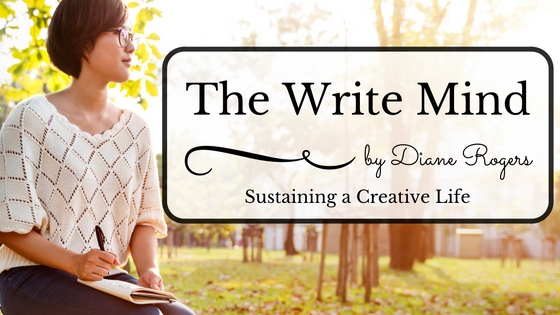by Dr. Diane Rogers
A Creative Fraud?
If creativity is an act of generosity, then color me Grinchy-green. I’ve been stingy with my writing lately. At a time of year when munificence is front and center, I am left lamenting my lack of achievement over the last 365 days. I have little to show for my literary endeavors. It’s enough to want to make me wallow in eggnog.
How can I feel festive when each passing December day knells a glum reminder of my creative un-complishments—my un-finished novel, the un-submitted manuscripts, the un-awarded literary prize?
Raising my fist to the proverbial heavens, I shout (to myself), “There was so much I wanted to do! So much I wanted to write!” A triple digit list of un-dones dances in my head while I knock back another cup of holiday cheer. Oh, joy. Meanwhile, a humongous stash of handwritten notes for my novel wait patiently beside my computer in an overflowing “To Do” basket.
I want to hang a “Fraud” sign on my forehead. Can I really call myself “creative” without the accompanying results?
Re-imagining Creativity
To evaluate literary outcomes exclusively by tangible achievements is to misjudge the essence of creativity. A creative life It doesn’t boil down to a page count, a dollar figure or the number of copies sold. Creativity isn’t what we do, it’s who we are. It manifests first in the way we live and later in what we produce. Put another way, we are able to bring things into existence because we are creative beings first. Best-selling self-help author, Brene Brown says creativity is how she shares her soul with the world. Anybody care to quantify that? Not me.
Food for Thought
The words generate (to create) and generosity share the same etymology. Both are derivatives of the Latin gene, meaning “to give birth” or “to produce.” At their core, acts of generosity and generation signify the act of bringing something to life. In the 14th century, the Latin word generosus denoted the status of nobility—a noble birth. By the 17th century, the meaning of generosus expanded to imply unselfishness through its association with the word magnanimus (literally meaning great (magnus) soul (animus)).
To create and to be generous are both intentional, life-giving (gene) acts. Creativity and generosity are also noble human attributes (generosus)—traits that allow us to share our souls with the world to promote connection and belonging. Think of the two not just as nouns, but as joint midwives at the portal of new beginnings. Together they give rise to fresh thoughts, feelings, ideas, dialogue, gestures, opportunities, atmosphere. Embedded in each are qualities that urge us toward the greater good and bring our innate greatness—our magnus animus—to light.
Could the true (perhaps loftier) purpose of creativity be to bring more life to our everyday lives?
Toward a Living Creativity
In the spirit of the holiday season, it seems fitting to challenge and expand traditional notions of creativity.
Full (selfish) disclosure: perhaps it’s because I’m beating myself up over not have achieved my writing goals this year. Maybe my need to explore this topic comes from a deeper desire to envision a kind of creativity that isn’t limited to hanging on walls, sitting on bookshelves, or drifting in digital purgatory.
Full (comedic) disclosure: I also believe in unicorns.
Maybe not all of us have the capacity to produce a NY Times Bestseller, but each of us can—as Mother Teresa urged—do small things with great love.
Day-to-day kindness, for example, engenders both creativity and generosity. “Doing good” in the world one day at a time may sound superficial, but it requires both generative and creative thought and action. A living creativity manifests in all manner of generous gestures—the doors we open for strangers, the patience, tolerance, and respect we offer others, our daily contributions to family and community. Creativity and generosity can come to life through a smile. We often forget that one of the kindest things we can do in life is to stop, slow down, and acknowledge another person as a fellow human being.
Small, mindful deeds bring happiness to others. Intentional generative, thoughtful, positive behavior also makes us feel good by bringing us face-to-face with our magnus animus.
The Creativity of Forgiveness
Big-heartedness isn’t just about giving, it also means offering forgiveness to others and to ourselves. It means being open to seeing and loving others for who they are rather than who we want them to be.
Joseph Chilton Pearce wrote, “To live a creative life, we must give up the fear of being wrong.” He didn’t say this to suggest that artists have to be open to criticism. He meant that emotional growth requires the mental openness to rewrite long held beliefs, rewire old thought patterns, and invent new ways of being.
 Here’s a personal example. Whenever my mother shows up on my doorstep, she hands me some kind of gift. “Oh, how nice,” you say. Sure. Over the years, she has bestowed on me a closet full of useless trinkets—items I neither need nor know what to do with. The pragmatist in me thinks it’s wasteful. “But I’m a grown woman,” I protest, gritting my teeth. “I don’t need more stuff, mom.” I beg her, over and over again to stop. My pleas have fallen on deaf ears.
Here’s a personal example. Whenever my mother shows up on my doorstep, she hands me some kind of gift. “Oh, how nice,” you say. Sure. Over the years, she has bestowed on me a closet full of useless trinkets—items I neither need nor know what to do with. The pragmatist in me thinks it’s wasteful. “But I’m a grown woman,” I protest, gritting my teeth. “I don’t need more stuff, mom.” I beg her, over and over again to stop. My pleas have fallen on deaf ears.
This holiday season, I have decided the best present I can give my mother is to put my living creativity into action. It stems from the authentic desire to create a better relationship with her.
A Challenge
Through deep reflection, I challenged my long held belief and values, bent my entrenched mindset, and considered old ideas from new angles. After considerable creative re-imagining, I have come to see that “cute little packages” and knick-knacky gifts are my mother’s way of bringing her own magnanimous creativity to life.
Although it may sound simplistic and inane, the intentional process of perception change requires both creativity and generosity. A living creativity life takes willingness, focus, attention, and self-reflection—the same skills required to write a novel.
This year when my mother hands me a beautifully wrapped and carefully selected package, instead of cringing, my mangus animus will smile authentically at her mangus animus. I will hug her and offer my genuine, heartfelt thanks. I’m done with being a stingy receiver. As Biology of Belief author, Dr. Bruce Lipton says, “Re-write perception and you re-write behavior.”
So, if re-writing a tired old personal story with a creative new twist turns out to be the most creative thing I’ve done all year, I’m okay with that.
A happy ending is a happy ending.
How does a living creativity put more life in your life? Contribute generously to our community with your comments.
***

Dr. Diane Rogers, Author
After retiring from a corporate career in business transformation and change management, Dr. Diane Rogers brings her expertise in social psychology to classrooms and families.
Her first picture book, Stand Tall, made its debut at the 2008 Seeds of Compassion Conference in Seattle, Washington featuring His Holiness the 14th Dalai Lama. A week after the book’s release, the State of Washington selected Stand Tall as an official teaching resource for compassionate education. Diane’s other published works include Emerge, A Story of Confidence, and When We All Stand Tall. To find out more, visit www.drdianerogers.com.
A self-professed global nomad, when they aren’t traveling on or jumping out of planes, Diane and her husband Kevin triangulate between Sydney, Australia, Newport Beach, and their sailboat in the Mediterranean.
**O.C. Writers is a member of Amazon Associates. By clicking any of the book links on this site, the network earns a small commission from your purchase..





Yep, this is a new way of looking at creativity, very holistic. Since I’m a deadline-driven, To Do List kind of gal, I’ll have to think how to translate that to practical actions. I like the compassion aspect.
Hi Michelle,
Thanks for your important feedback. I can really relate to being a driven, “To Do List kind of gal.”
Bringing a “living creativity” into action is about noticing and staying open to the things that aren’t on the to do list. Living creativity means consciously creating moments of connection with others and with yourself.
For those of us who love achievement, “living creativity” can become a fun, innovative “To Do List” item. For example, make Mondays an “acknowlege someone in a creative way” day. Tuesdays can be “recognize the good” day. Perhaps Wednedsay are good day for hugging those you love a little harder. When it comes to “living” creativity, the sky’s the limit.
Have fun!
so tears here – not only relating to “the unfinished novel,” but to the other side of creativity that you mention – “This year when my mother hands me a beautifully wrapped and carefully selected package, instead of cringing, my mangus animus will smile authentically at her mangus animus”.
I know how it feels to be on the receiving end of “a generous receiver”. One of my loveliest memories is walking into a friend’s house whom I hadn’t seen in more than 10 years. She gave us a tour of the house I had never visited. When we got to the basement, she opened the door to a little-used room. There on the wall was a dusty burlap wall hanging with a gigantic sunflower embroidered with crewel yarn blatantly shouting it’s discolored yellowness out to the world. I had made that wall hanging for my friend in the early 70s and she STILL had it! No matter what she might have thought of that kitschy burlap wall hanging when I had given it to her, I responded to it hanging on the wall as your mother must have responded when you “generously received” this year’s gift of herself to you.
This is a lovely piece, Diane, and (I might add) filled with creativity. I can see an essay on kitchy gifts or another book in your children’s book series here. I love it!
Billie, Thank you for sharing your beautiful story. It touches the heart. My magnus animus is smiling at yours. 🙂
So, I just unburied myself from my to-do list long enough to read your lovely post and it made me sigh. A good sigh. A that’s-right kind of sigh. Now, back at it.